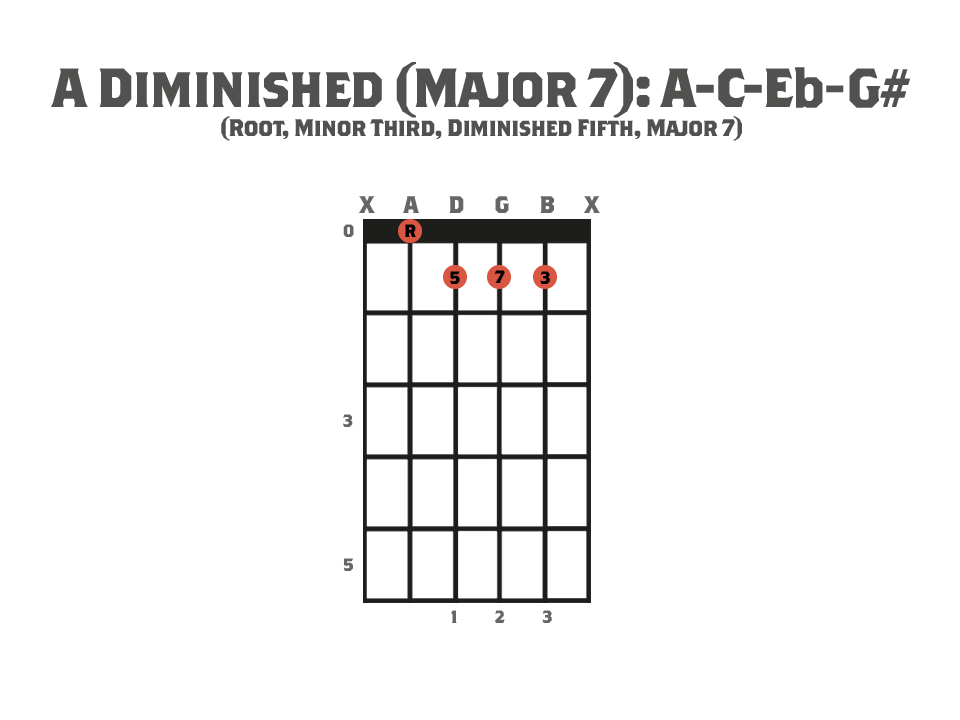Welcome to part 2 of our exploration of seventh chords. In part 1 we looked at the more common types of sevenths, in this part we’re going to look at some which you won’t come across as often.
You can get some quite unusual sounds from some these chords because of their altered extensions. Remember these chords will be derived from a particular scale or mode and some of these chords are exclusive to their mode.
The chords we’ll be looking at are:

These chords are considered “altered chords” because one or more of the notes have been raised or lowered by a semi-tone. This alters the sound and feel of the chord.
There are several different ways to use altered chords. For example:
To Create Tension
Raising or lowering notes in a chord can ‘throw off’ the listener, especially if they’re expecting to hear a particular chord or sound.
A simple example would be if you have a II-V-I progression and alter the V chord to a V+7. In the key of D Major this would be Em – A+7 – DMaj.
Changing Key
We can move from one key to another using an altered chord as a passing chord. For example in D Major ‘A7’ is the V chord, if we move from A7 to A7b5 we get the notes A-C#-Eb-G, then we can move to Eb7 and then AbMaj both of which are in the key of Ab Major.
Creating an Ascending or Descending Melody Line
You may have heard the term “walking bassline”. This is were the bass plays notes chromatically ascending or descending. You can also create chromatic lines in the melody by raising or lowering notes in a chord.
For example if we play Gm – F7 – Am7b5 – Am7 – Am7#5 – Am6 – GMaj. The fifth in the A chords changes with each one from Eb to E to F then we get F# in the Am6 witch leads us nicely up to the G chord.
Chord Diagrams
Check out the diagrams below for some open position versions of the chords. Once you understand how each one is formed you can start experimenting with different ‘voicings’. Try working some of these less common chords into your music! (They also make some interesting arpeggios!)
A7#5
Lets start with A7#5. As the name suggests this is an A7 with a sharpened fifth. It can also be called A+7 (A Augmented Seven).

You can also play this chord with the #5 on the high E string instead of the 7. (Play the 1st fret instead of the 3rd).
You may have noticed the ‘E#’ note in this chord. Although technically this would be the note ‘F’ since E# doesn’t exist we call it E# in this context as ‘F’ would imply a flat 6 interval in relation to ‘A’ rather than a sharp 5.
Am7#5
As with the previous chord this one contains a sharp 5th (E#). However we have a minor 3rd and and again, a minor 7th.

As you can see the shape is the same as the A7#5 but we have moved the 3rd back a fret (From 2nd fret B string to the 1st fret).
Since we have the 7th on the open G string you could play the “E#” on the 1st fret E string instead of playing the 7th (G) on the 3rd fret. Alternatively keep the 7th on the 3rd fret E string and replace the open G string with “A” on the 2nd fret, this will give the chord a slightly different sound. Experiment to see what you prefer or what works best in a given scenario.
AMaj7#5
You could also call this A Augmented Major 7 (A+Maj7). As with the previous two chords we are using a #5 interval, only this time we have a Major 3rd and a Major 7th.

The shape is similar to the last chord but we now have a Major 7 which I have placed on the 1st fret of the G string. You could also play it on the 4th fret of the high E string.
If we ignore the root note (A) that leaves us with a C# Major chord triad. This could also be viewed as a C#(addb13) chord, with the b13 in the bass. You could experiment with voicings that place the A higher up and have the C# in the bass. (By “in the bass” I just mean play it as the lowest pitched note)
A7b5
A Dominant 7 flat 5. By now, hopefully you are starting to get a feel for the naming conventions. Here we have an A7 (A – C# – E – G) but with a flattened fifth (A – C# – Eb – G). So its similar to Am7b5 from the previous post, except the 3rd is Major instead of minor.

This chord, in my opinion, has quite a nice sound to it considering that it contains two diminished 5th intervals (Eb is a dim5 above A and G is a Dim5 above C#). But it also has two Major 2nd intervals (C# to Eb and also G to A) so it has a bit of a “Sus2” feel.
AMaj7b5
This is the same as the previous chord except we have a Major 7 instead of a minor 7 interval. (The Root, Major 3rd and b5 remain the same).

We can also play the Major 7 to the 1st fret G string. You could also look at this as being an inversion of DbSus2(Addb13). This may sound a bit long winded but basically just means DbSus2 with a m6 added to it. (Db is the same note as C# and a m6 is the same as a b13. Although you would expect the b13 to be in a higher octave). You could therefore rearrange the notes to have the A higher up and use Db as the root note.
By trying different fingerings and altering the order of the notes you can find some interesting ways of fitting these less common chords in to your progressions!
Okay, lets look at one more…
A Diminished (Major7)
This can be written as an A followed by a little circle (to represent diminished) and then Maj7. (Also you will sometimes see a triangle to represent “Major”).

For a chord with quite a complex name the fingering is surprisingly simple! Just play an A Major chord and move everything except the Root on the open A string back one fret. In fact playing back and forth between AMaj and ADim(Maj7) can give you quite a cool sound.
As usual if we re-arrange the notes we can see that this could also be referred to by a different name. If we use the G# as our Root note and rename it Ab we get Ab(Addb9) = Ab-C-Eb-A.
Often people come across chords which don’t sound “nice” when you try strumming them the way you would with more common chord types and end up not using them. If you use them in the right way they can really help to add some interest to your music. Even of its just a dissonant passing chord that makes the next chord sound nice.
Hopefully you’ve enjoyed looking at these less common chord types and have some ideas for making use of them.
Footnote: The guitar featured in the cover image of this post is the ‘Jem 77P’ made by Ibanez Guitars for Steve Vai as a part of his signature guitars.


Join The Strings of Rage Syndicate!
Take your guitar playing to the next level. Join the community for exclusive new lessons, ideas and over the top guitar creativity! We look forward to seeing you around!









No Comment